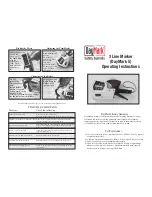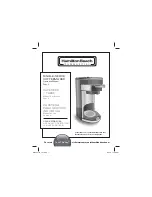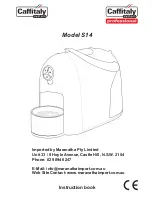
EN
- 26 -
HOW TO ADD THE INGREDIENTS
- Follow the order indicated in the recipe.
- Keep additional ingredients (fruits, nuts, raisins, etc) on one side and add them during the second
kneading when the appliance beeps 10 times.
- First introduce the liquid ingredients. Usually it is water but can include milk and/or eggs. Water
must be warm (37°C / 100°F), but not hot. The too hot or too cold water prevents the leavening.
- Do not use milk with the timer. It could curdle before beginning the bread preparation process.
- Add sugar and salt as indicated in the recipe.
- Add the "liquid" ingredients (honey, syrup, molasses, etc).
- Add the "dry" ingredients (flour, milk powder, herbs and spices).
- If you use the timer, it will not be possible to add fruit or nuts during the second kneading, so add
them now.
- At last add dry yeast (or baking powder/sodium bicarbonate). Place it over the other ingredients -
do not put it in the water, otherwise it will begin to act too soon.
- If you use the timer, it is essential to keep the yeast (baking powder/baking soda) separate from
the water/liquid, otherwise the yeast will come into action, it will rise and collapse before the bread
making process begins. The result will be a hard, dense, rough and edible product as a brick of a
home. We advise to make a hole in the centre of the dome of the flour and put the yeast.
Flour
The type of flour you use is very important. The most important element contained in the flour is the
protein called gluten, which is the natural agent that gives the dough the ability to mould and to retain
the carbon dioxide produced by the yeast. Buy flour which on the package shows "TYPE 0" or "FOR
BREAD" (like Manitoba), the latter has a high gluten content.
Other flours for bread
They include wholegrain flour and other cereals.
They provide an excellent dietary fibre intake but contain lower levels of gluten than white "type 0"
flour. This means that the wholegrain loaves tend to be smaller and denser than the white loaves.
In general terms, if in the recipe you replace white "type 0" flour with half wholegrain flour, you can
prepare a product with wholegrain bread taste and the texture of white bread.
Yeast
Yeast is a living organism that multiplies in the dough. In the presence of moisture, food and heat, the
yeast will grow and will release carbon dioxide gas. The latter produces bubbles that are trapped in
the dough and make it grow.
Among the various types of yeast available we recommend using dried active yeast. These are nor-
mally sold in bags and must not be previously dissolved in water.
You may also find "fast-acting" yeast or "yeast for bread machines". These are stronger yeasts that
have the ability to make the dough rise 50% faster compared to other ones. Use them only with the
"QUICK OPTION" setting. Yeast in bags is very sensitive to moisture, so do not store partially used
bags for more than one day. Alternatively, you can use fresh yeast blocks: 1 g of dry active yeast is
equivalent to 3.5 g of fresh active yeast.
Содержание 00C013300AR0
Страница 2: ...Fig 1 A B C D E F I L M N Fig 2 Fig 4 Fig 3 G H O P Fig 5 Q P O N F E A B D C M L H I G R ...
Страница 207: ......
















































